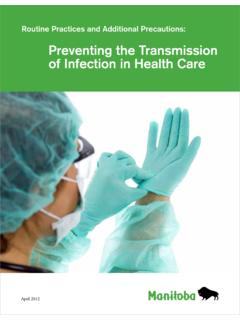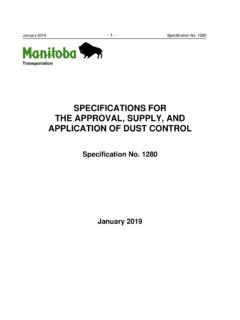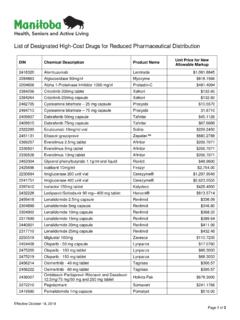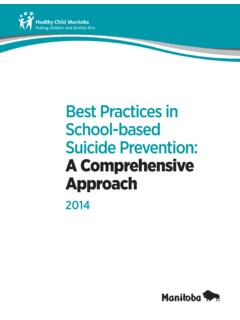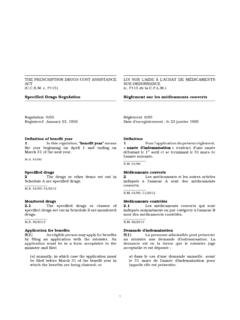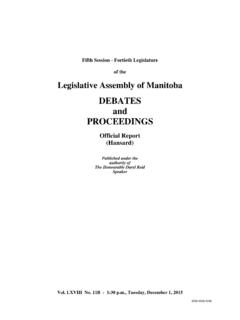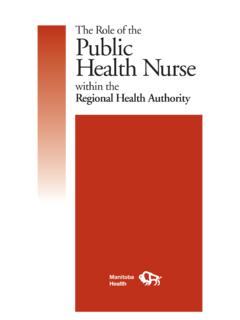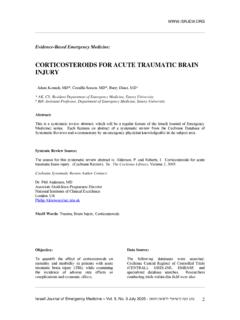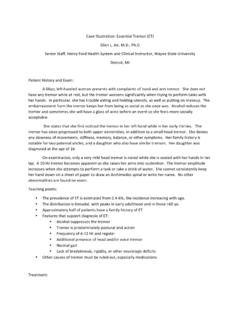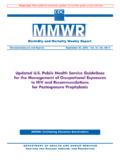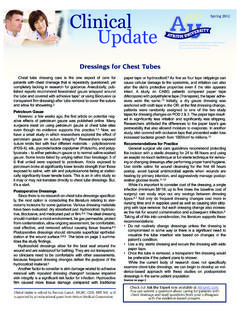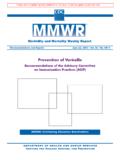Transcription of UPDATE: Mumps Outbreak and Testing Processes
1 Active Living, Population and Public Health Communicable Disease Control 4th Floor, 300 Carlton St, Winnipeg, MB R3B 3M9. T 204 788-6737 F 204 948-2190. April 26, 2017. update : Mumps Outbreak and Testing Processes Mumps continues to spread throughout Manitoba. As of April 21, 2017, Manitoba Health, Seniors and Active Living st (MHSAL) has confirmed 323 cases of Mumps in Manitoba since September 1 2016. Manitoba typically experiences four to five cases of Mumps per year. For updated information about Mumps , please visit the MHSAL Mumps disease webpage: Updated Reporting and Testing Procedure for Mumps : Testing of suspected clinical cases of Mumps are to be conducted by the following: o Buccal swab for symptomatic cases. The swab should be taken from the area by the parotid duct and placed in viral transport medium. Viral swabs from the parotid duct are best collected within 5 days of disease onset.
2 Results of PCR are usually available within 2-5 days. Culture can take 10 days. o Serology ( Mumps IgM and IgG; Red-top tubes) should be done, in addition to buccal swab, where the suspected case is beyond 5 days since symptom onset. o Urine samples are no longer necessary during this Outbreak . o Please provide clinical signs and symptoms and their date of onset on the CPL General Requisition. The current positivity rate when there is a clinically compatible syndrome is 30-50%. Manitoba's Mumps Communicable Disease Protocol outlines the recommended public health management of cases/contacts and health care provider reporting requirements. ( ). Infection Prevention and Control: Healthcare facilities should refer to MHSAL's Routine Practices and Additional Precautions: Preventing the Transmission of Infection in Health Care located at: Health care staff who have 2 documented doses of MMR vaccine are considered to be immune and serology is not required.
3 If serology is inadvertently done in workers who have 2 recorded doses of MMR and results show negative IgG, additional doses of MMR are not required. For Vaccine Eligibility See: ( ). Please share this communication with all colleagues in your department, facility or clinic. For questions, please contact MHSAL at 204-788-6737. Sincerely, Original signed by Original signed by . Richard Baydack, PhD Richard Rusk, DVM, MD, CCFP, MPH. Director Medical Officer of Health Communicable Disease Control Communicable Disease Control Page 1 of 1. Public Health and Primary Health Care Communicable Disease Control 4th Floor, 300 Carlton St, Winnipeg, MB R3B 3M9. T 204 788-6737 F 204 948-2040. November, 2015. Re: Mumps Reporting and Case Investigation Reporting of Mumps ( Mumps virus) is as follows: Laboratory: All positive laboratory results for Mumps virus are reportable to the Public Health Surveillance Unit by secure fax (204-948-3044).
4 Health Care Professional: Probable (clinical) cases of Mumps are reportable to the Public Health Surveillance Unit by telephone (204-788-6736) during regular hours (8:30 to 4:30 ). AND by secure fax (204-948-3044) on the same day that they are identified. After hours telephone reporting is to the Medical Officer of Health on call at (204-788- 8666). The Clinical Notification of Reportable Diseases and Conditions form ( ) should be used. Cooperation in Public Health investigation is appreciated. Regional Public Health or First Nations Inuit Health Branch (FNIHB): Once the case has been referred to Regional Public Health or FNIHB, the Communicable Disease Control Investigation Form ( ) should be completed and returned to the Public Health Surveillance Unit by secure fax (204-948-3044). Sincerely, Original Signed By Original Signed By . Richard Baydack, PhD Carla Ens, PhD. Director, Communicable Disease Control Director, Epidemiology & Surveillance Public Health and Primary Health Care Public Health and Primary Health Care Manitoba Health, Healthy Living and Seniors Manitoba Health, Healthy Living and Seniors Communicable Disease Management Protocol Mumps Communicable Disease Control Branch 1.
5 Case Definition 2. Reporting Requirements Confirmed Case Laboratory: Consistent clinical illnessa with laboratory All positive laboratory results should be confirmation of infection in the absence of recent faxed (204-948-3044 secure fax) to immunizationb with Mumps -containing vaccine. Manitoba Health, Public Health Surveillance Unit. Isolation of Mumps virus from an appropriate clinical specimen Operators of Manitoba clinical laboratories are required to submit to Cadham or Provincial Laboratory (CPL) the residual Detection of Mumps virus RNA serum, plasma or respiratory specimens or respiratory viral isolate sub-cultures from or individuals who tested positive for Mumps Seroconversion or a significant rise in virus within seven days of report. Mumps IgG titre between acute and Health Care Professional: convalescent sera by any standard serologic assay The Communicable Disease Control Investigation Form (available at: or ).
6 Positive serologic test for Mumps IgM should be faxed (204-948-3044 secure antibodyc in a person who is either fax) to Manitoba Health, Public Health epidemiologically linked to a laboratory- Surveillance Unit when a health confirmed case or has recently travelled to professional becomes aware that a person an area of known Mumps activity. meets or has recently met the probable or confirmed case definition for Mumps . OR. Clinical illnessa in a person with an epidemiological a Characterized by acute onset of unilateral or bilateral link to a laboratory-confirmed case (1). tender, self-limited swelling of the parotid or other salivary gland, lasting > 2 days, and without other Probable Case apparent cause. A laboratory-confirmed case may not exhibit clinical illness, as up to 30% of cases are Clinical illnessa in the absence of appropriate asymptomatic (1). laboratory test results ( , no laboratory tests have b The most frequent reaction to Measles- Mumps -Rubella been performed) and in the absence of an (MMR) immunization is malaise and fever (with or epidemiologic link to a laboratory-confirmed case without rash) occurring 7-12 days after immunization.
7 In a person who has recently been to an area of Parotitis has occasionally occurred after immunization. known Mumps activity (1). However, this should be determined for each case as these reactions and timeframes can vary (1) (refer to Note: Surveillance for Mumps focuses on evident current Canadian Immunization Guide). disease rather than infection. Therefore, surveillance c IgM serology may be a false positive. If the clinical definitions do not take into account asymptomatic presentation is inconsistent with a diagnosis of Mumps or subclinical infections that may be detectable by or in the absence of recent travel/exposure history, IgM. laboratory methods. results must be confirmed by another listed confirmatory method (1). Communicable Disease Management Protocol Mumps July 2010. 1. Communicable Disease Management Protocol 3. Clinical Presentation sneezing, sharing drinks or kissing) (6, 7).
8 Immunized individuals do not transmit Mumps vaccine virus (5). Prodromal symptoms are usually non-specific and Importation from countries with low vaccine may include low-grade fever, anorexia, malaise and coverage rates presents an ongoing risk to under- headache (2). The most prominent manifestations vaccinated individuals and communities (8). of this disease are swelling and tenderness of the salivary glands; one or both parotid glands are Occurrence affected in most cases (2). Generalized nonspecific symptoms or primarily respiratory symptoms occur General: Endemic worldwide (2). In temperate in about half of infected persons (3). Symptoms climates, winter and spring are peak seasons (6). usually resolve three to 10 days after onset of illness The incidence of Mumps remains high in (2). Subclinical infection is common (3). countries without childhood Mumps vaccination, particularly in children aged five to nine years (6).
9 Central nervous system (CNS) involvement (i. e., Canada: From 2000-2006, an average of 79 cases aseptic meningitis) is the most common extrasalivary were reported annually, ranging from 28 in 2003, gland manifestation of Mumps (2, 4). Orchitis is a to 202 cases in 2002 (9). The age distribution of common complication in men after puberty, but Mumps in Canada has changed following the seldom results in sterility (5). Other rare introduction of universal childhood complications include arthritis, thyroiditis, mastitis, immunization the proportion of cases aged 20. glomerulonephritis, myocarditis, endocardial years and older increased from 14% in 1988- fibroelastosis, thrombocytopenia, cerebellar ataxia, 1990, to 64% in 2003-2005 (9). Conversely, the transverse myelitis, ascending polyradiculitis, proportion of cases aged 1-9 years fell from 49%. pancreatitis, oophoritis and deafness (5). to 17% during the same period (9).
10 In the absence of immunization, Mumps usually Manitoba: Three cases were reported in 2006, occurs in childhood (5). Infection tends to be more eight cases in 2007 and two cases in 2008. In severe in adults (5).There is no firm evidence that 2007, cases occurred over a wide age Mumps during pregnancy causes congenital distribution, from under one year of age to 40- abnormalities (2, 5). Mumps infection during the 49 years. In 2009, an Outbreak occurred in a first trimester of pregnancy is associated with an correctional facility, resulting in five cases. increased rate of spontaneous abortion (5). Incubation Period 4. Etiology The average incubation period for Mumps is 16-18. days with a range of 12-25 days (5, 6). Mumps virus is a member of the Paramyxoviridae family (2), genus Rubulavirus (6). Multiple Host Susceptibility and Resistance genotypes (strains) of the Mumps virus exist (7), but there is only one serotype (2).
